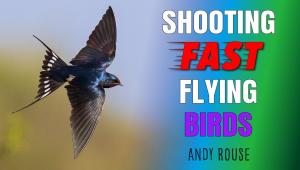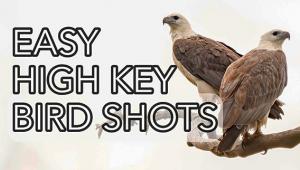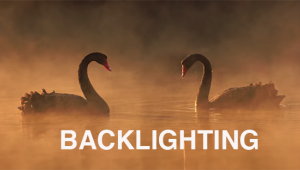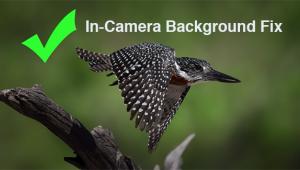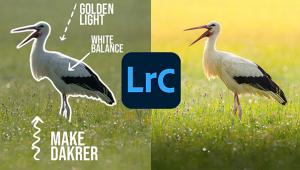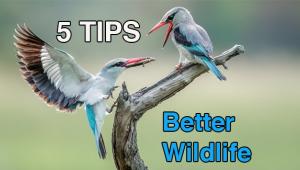Walking on the Wild Side: How to Turn Your Passion for Wildlife Photography into Profit

For this month’s column, we look at how to turn your love for wildlife photography into a serious business. I interviewed the husband-and-wife team of David and Jennifer Hemmings who have been particularly successful in the wildlife photography field.
David Hemmings, president of Natures Photo Adventures, is a world-renowned bird photographer known for creating some of the most dynamic and impressive in-flight bird images anywhere today. His work has been published on the covers of National Geographic and Canadian Geographic and in numerous other nature photography publications.
Jennifer Hemmings, co-owner and travel blogger for Natures Photo Adventures, has traveled the world with her camera. She has trekked to the remote area of tundra in Manitoba, Canada, to photograph and experience wild polar bears. She has endured whiteout conditions, the silence of the Canadian tundra, and extreme cold weather in pursuit of her nature photos.
Shutterbug: How did you both get into this field of photography as it is so specialized?
David Hemmings: I have always had a passion for photography and started back in the days when it was film and very expensive. I started taking photos at local zoos and at parks in Ontario. I taught myself how to photograph wildlife with many hours in the field. I have always loved birds and nature and started photographing birds in flight for more challenging photography. One day, when out in the field, a day that would impact my life forever, I went out in the hopes of photographing a snowy owl in Quebec. It was extremely cold with temperatures near -30 degrees Celsius. The sky was a vivid blue and at that moment I had a memorable encounter with a snowy owl. I was able to capture this beautiful bird in flight with wings fully spread looking straight at me with yellow eyes and a pristine blue background. It is one of the best images and photographic moments I have ever had.
Jennifer Hemmings: When I met Dave he mentioned he had a photography hobby. It was clear within the first couple of months of living together that it was a passion and an obsession. He is a “diehard” photographer. I joined Dave on many of his outings and learned how to photograph wildlife and then started co-leading some of his workshops. I also quickly fell in love with nature photography.

SB: Did you start straight off in nature and wildlife or in another field of photography? When did it become your major source of income and what decisions did you have to make along the way?
David: I started with wildlife and nature photography and I am constantly looking for new and interesting places to visit and wildlife to photograph. I made the decision to start teaching when I kept getting contacted by other fellow photographers asking questions and offering comments on my images. Many of them suggested I start teaching, so I started Natures Photo Adventures - David Hemmings Photography Tours.
Jennifer: I started right off in this field of photography and currently work a dual role of operations for Natures Photo Adventures as well as being a workshop leader. I also assist with scouting out new locations and wildlife such as our new Wild Wolves and Bald Eagles Tour. I spent over a week in a blind in the hopes of photographing wild wolves in the winter in Canada. It was one of the most incredible experiences I have ever encountered.
SB: What kind of equipment do you use now, and what did you start with?
David: Now I use Canon 1D Mark IV’s and Canon 7D Mark II’s for the extra crop sensor and video capabilities. I use the Canon 500mm f/4 lens for most of my work but also have the Canon 100-400mm II in my bag. I started with the Canon 1D Mark II, which was only eight megapixels, and used the Canon 400mm f/5.6 with it.
Jennifer: Being the wife of David Hemmings, I have access to all his camera equipment and get those hand-me-downs when he gets a new camera body and lens.

SB: What are some of the considerations to prepare for one of your nature and wildlife photography tours when there are so many variables?
David: Being prepared is extremely important on our wildlife tours, especially the ones with extreme cold temperatures. We prepare a list of all equipment and clothing and supplies to ensure everyone is well equipped for all the tours, including the Polar Bear Mother and Cubs at the Den and the Wild Wolves workshops. We also bring a backup camera and lens should one of our workshop participants have a technical problem with their gear when we are in remote areas.
SB: What do you see as being your most satisfying accomplishment so far in the field of nature and wildlife photography?
David: Being able to travel the world, teach others, and share my passion. It’s always wonderful news when we hear one of our participant’s photographs has won a photo contest or is being published in a magazine. Watching someone transition from not understanding any of their camera settings to capturing a “bird in flight” image and understanding the how and why behind it is very gratifying.
Jennifer: Going out into the wilderness on my own to scout for the wolves was the most extreme wilderness experience I have ever encountered. Being by myself in a blind and then watching nature unfold before me was stunning. I got a taste of extreme wildlife photography and now I am hooked. There is also something special when you get the opportunity to see and photograph unique wildlife moments with others.

SB: What percentage of your photography is licensed for stock and what type of clients do you usually work with? Also, how do you feel about pursuing travel photography/writing assignments and publishing?
Jennifer: Of our sales 5 percent are with print and image sales. We would like to expand more in the future. We sell images and stock images to private individuals, through our website and some online stock agencies. They tend to contact us when they notice one of our images online. We have also published e-Books. David has one hardcover book with other photographers called On Feathered Wings. We both currently write travel assignment blogs with other companies to promote our business.
David: Our main business is teaching nature photography to our clients through direct sign-ups for our photo adventures to many different parts of the world. Our client base is primarily people with a keen interest in nature photography who want a trip and workshop where many of the unknowns and variables are taken care of by our knowledge of our destinations and species that we photograph.
SB: How important is videography to your business?
Jennifer: We are noticing greater interest in videography and we take video footage for marketing purposes. We will be promoting videography workshops in the future. We have a YouTube channel with our wildlife videos and how-to photo lesson videos on our website full of photo tips.

SB: For marketing results, what seems to work best for you and how often do you contact clients?
David: For our business we have found that social media is our top venue for attracting clients. Word of mouth is also a contributing factor to the success of our business. We also do e-mail blasts at least once a month. We have found that information mixed with images works well as opposed to the typical “look what we are selling today” approach.
Jennifer: We use Wix.com for our website and a combination of social media, including Facebook, Pinterest, and Twitter. Our popularity comes from our images published in the photo community and by our workshop participants.
SB: What advice do you have for those looking at getting into this field of nature and wildlife photography, pitfalls to avoid and opportunities to pursue?
David: It is important to have a true passion for what you are doing. Even though this is not always possible, it helps to create good work if you do have a passion for what you are working on. Try to differentiate yourself from the crowds any way you can. Think outside the box is a well-worn phrase but a very useful one to remember in this field!
Jennifer: Find out what type of photography interests you. Join online forums and go on a photography workshop with a reputable company. For example, if you decide you have an interest in wildlife photography and would like to photograph grizzly bears, consider joining a photo workshop designed for grizzly bear photography.

SB: What skills or areas of expertise (other than photography) do you think a nature and wildlife photographer has to develop for a successful business model?
David: Good question. In relation to being organized for our workshop tours, I would say the most important skill would have to be people skills. You have to make people feel comfortable, appreciated and make sure that they enjoy themselves. The ability to think fast under pressure is also very useful.
Jennifer: Customer service and the ability to build instant rapport.
SB: What qualities or characteristics do you think are essential to successfully capturing these images (i.e., patience, physical stamina)?
Jennifer: Our timber wolf and eastern grey wolf images are the perfect examples of having patience and a willingness to endure subzero temperatures. Wild animals have their own plans and we are just observers watching nature unfold before us. They are not on our schedule. With the wild wolves, you have to wait patiently and be very quiet in a blind for hours.
SB: Is it all worth it?
Jennifer: There’s nothing more exciting than your adrenaline pumping when you get that shot! Nature is always full of surprises and wildlife is exactly what it is: wild and unpredictable. I love to share these experiences in hopes our workshop participants and blog readers feel as though they have also been on my adventures.
Resources
Natures Photo Adventures: naturesphotoadventures.com





